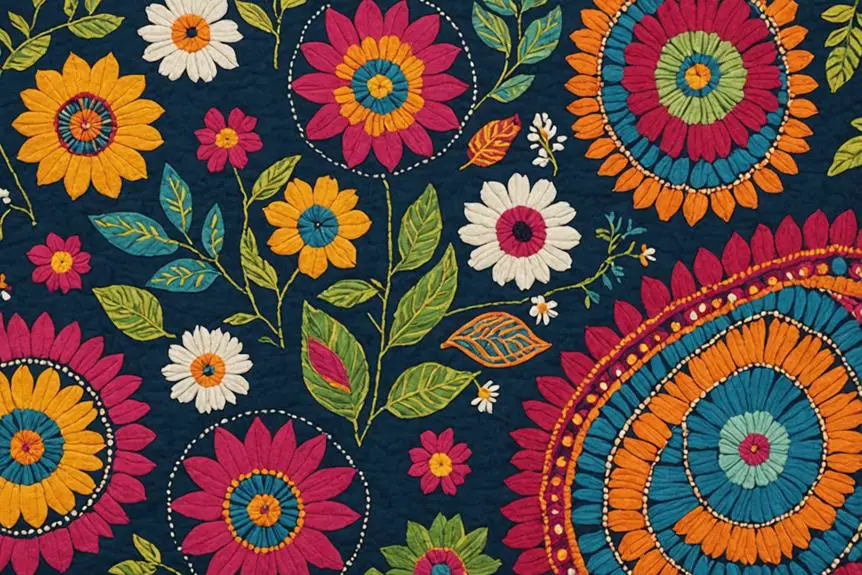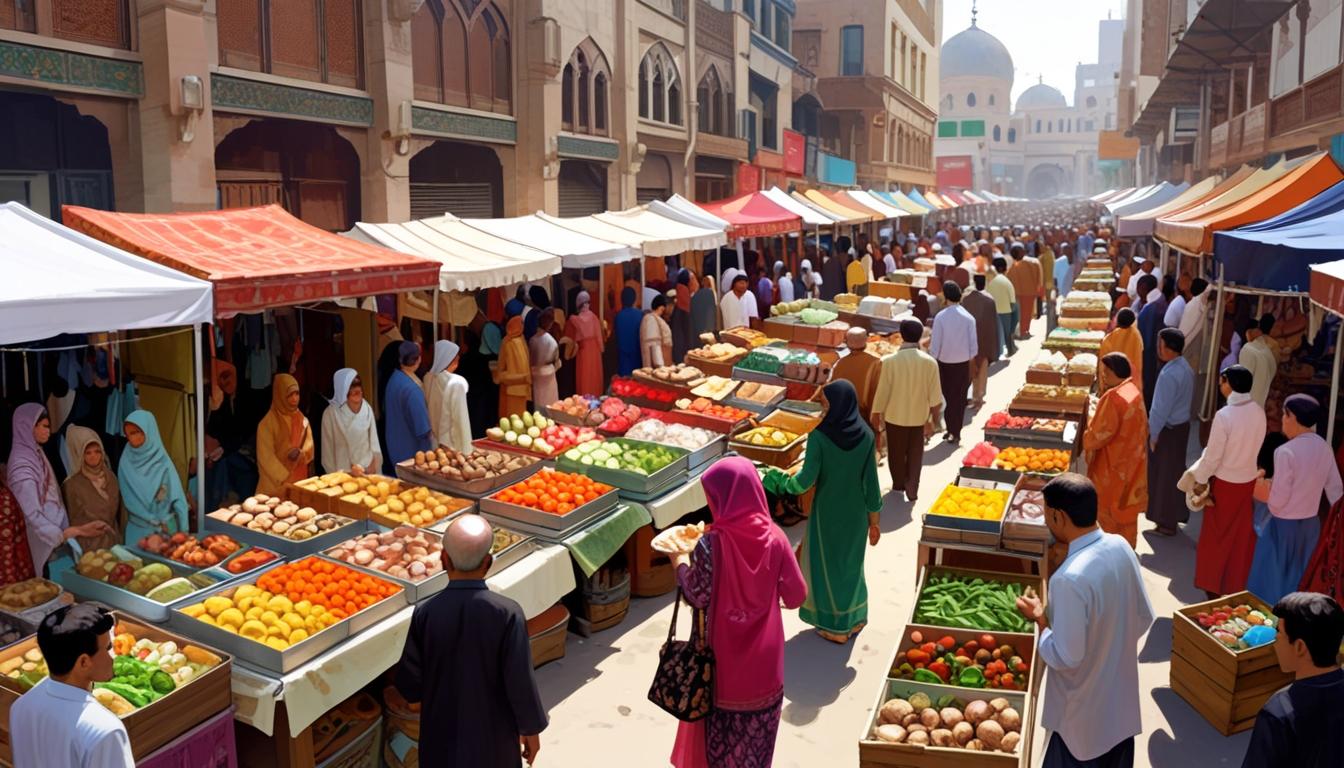When you're trying to identify Kantha fabric, it's important to focus on the details. Start by examining the stitching; authentic Kantha features straight, consistent running stitches that reflect skilled craftsmanship. Look for the fabric's composition, usually layered cotton or silk, and vibrant colors from natural dyes. Pay attention to the motifs, often inspired by nature, and check for neatly closed stitching edges. However, recognizing these elements is just the beginning; there's much more to uncover about what truly sets quality Kantha apart.
Understanding Kantha Fabric
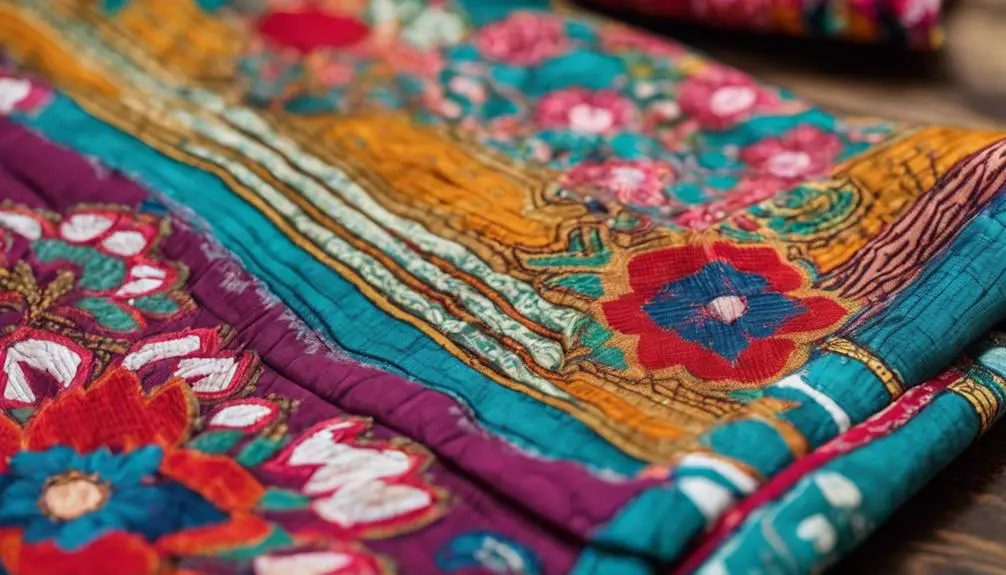
Kantha fabric is a vibrant demonstration to the artistry of hand-stitching, featuring a unique running stitch pattern that showcases the skill and creativity of its makers. When you think of kantha, picture colorful cotton fabric, often made from old saris and dhotis, lovingly repurposed into something beautiful. Isn't it amazing how something old can be transformed into a work of art?
Traditional Kantha embroidery isn't just about looking good; it tells stories! Each piece you see reflects the maker's experiences and the rich Bengali heritage. These fabrics are usually layered, often with two to six layers stitched together, making them warm and durable. You'll notice that the top layer often has vibrant hand-block printed designs, full of life and inspiration from nature and daily life.
Feeling the fabric is an experience in itself. Authentic kantha is soft to the touch and has a unique texture, thanks to the careful layering and stitching process. This sets it apart from mass-produced textiles. When you spot kantha fabric, you're not just seeing embroidery; you're witnessing a tradition that has been passed down through generations.
Key Characteristics of Kantha
When you examine Kantha fabric, you'll quickly notice its key characteristics that make it truly unique. One of the standout features is the running stitch. This simple running stitch isn't just functional; it creates beautiful, intricate designs that can range from simple lines to elaborate patterns. You'll often see contrasting threads that pop against the fabric, giving it that eye-catching charm.
Authentic Kantha quilts usually have multiple layers—think anywhere from 2 to 8 layers of repurposed cotton and silk. Many times, you'll find these pieces made from old saris and dhotis, breathing new life into forgotten textiles. How cool is that? The vibrant colors you see are often achieved through natural dyes, with motifs inspired by nature, daily life, and rich Bengali culture.
Another thing to love about Kantha is its softness and durability. The repeated stitching not only enhances the texture but makes the fabric sturdy enough for everyday use. Whether you're snuggling up in a Kantha Blanket or displaying an embroidered quilt on your wall, each piece tells a story. It reflects the personal touch and craftsmanship of its maker. So, when you encounter cotton kantha quilts, remember that you're not just looking at fabric; you're experiencing a unique blend of art, history, and sustainability. Isn't that amazing?
Techniques Used in Kantha
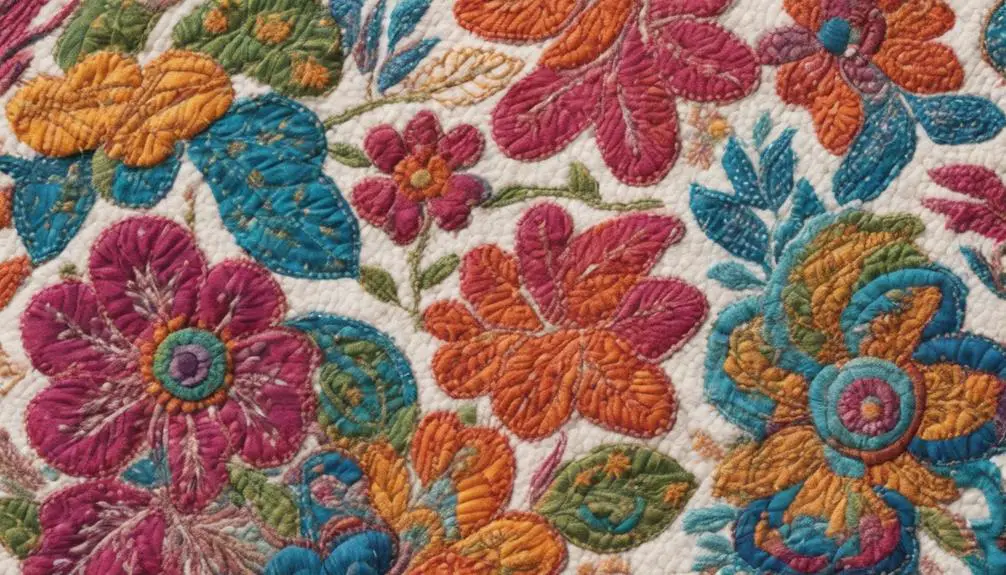
Delving into the techniques used in Kantha reveals a fascinating blend of tradition and artistry. If you're curious about how this beautiful fabric comes to life, you're in for a treat! The magic begins with the simple yet effective kantha stitch, which is basically a running stitch used to sew multiple layers of fabric together. It's like a warm hug for those old saris and cloth scraps you often see being transformed into stunning pieces.
Here are three key techniques that artisans use:
- Tracing Designs: Before they start stitching, artisans often trace designs onto the fabric. This guarantees that every motif is placed just right, keeping that traditional craftsmanship alive while letting creativity shine through.
- Using Recycled Materials: The base fabric usually comes from old saris, and the yarn is often sourced from sari borders. This not only promotes sustainability but also gives each piece a unique story.
- Stitching Density: The number of stitches per inch can vary, but high-quality kantha features straight and consistent stitches. This detail adds to the durability and beauty of the fabric.
Common Motifs and Colors
A vibrant array of colors and intricate motifs define the charm of kantha fabric. When you explore the world of kantha products, you'll notice that common colors include lively shades of yellow, red, green, black, and blue. These colors often mirror the daily life and surroundings of Bengal. Isn't it cool how natural dyes sourced from local materials are used to color the threads? It gives the fabric an authentic and eco-friendly twist!
Now, let's talk about those motifs. They're not just pretty patterns; they're inspired by everyday folk scenes, nature, and ancient arts. You might spot symbols like the sun, trees, and lotus flowers, all packed with meaning tied to folk beliefs. The base fabric is usually off-white, which really makes those vibrant shades pop!
What's super exciting is that each kantha piece is unique. You'll find variations in motifs and color combinations that tell the individual story of its maker and their cultural heritage. It's like wearing a piece of history! So, when you're looking at kantha fabric, pay attention to the details. The embroidery isn't just for show; it's a celebration of creativity and tradition.
Next time you see kantha, remember it's more than just fabric. It's a lively storytelling canvas, woven with passion and culture. How cool is that?
Assessing Kantha Quality
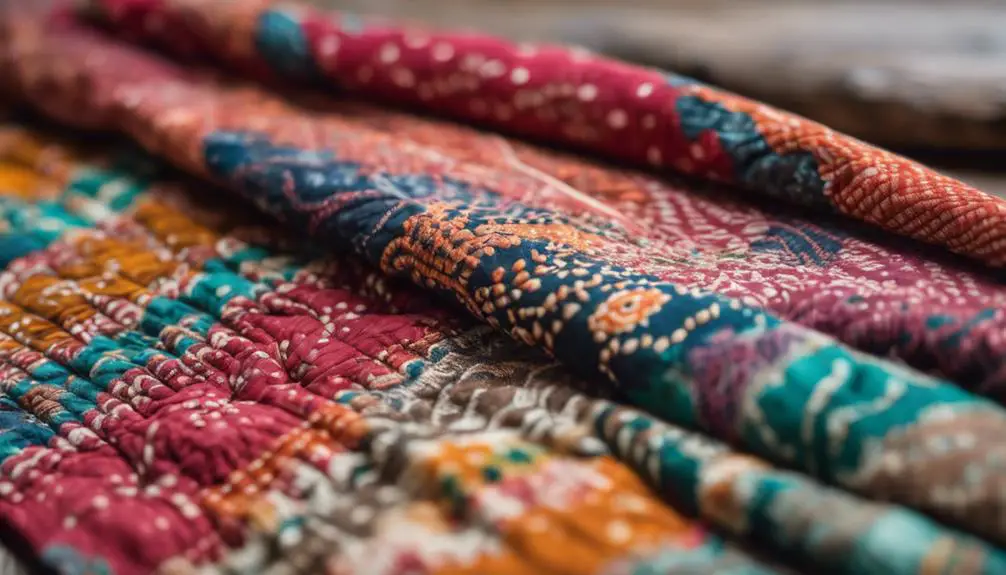
Evaluating the quality of kantha fabric is essential for ensuring you're investing in a piece that's not only beautiful but also durable. You want to make sure that the kantha you choose will stand the test of time, right? Here are some key factors to reflect on:
- Stitching and Running Stitches: Look closely at the stitching. Authentic kantha features straight and consistent running stitches. If they're uneven or messy, you might want to keep looking. Higher-quality pieces will have tighter and more uniform stitches, showing that care was taken during the crafting.
- Fabric Material: The type of fabric used can tell you a lot about its quality. Higher-quality kantha is made from better materials, like silk or high-thread-count cotton, which not only feel luxurious but also last longer. So, give it a good feel; softness is a good sign!
- Edges: Don't forget to check the edges! Authentic kantha should have neatly closed and straight edge stitching. If the edges are fraying, that's a red flag.
And let's be real, price matters too! If you see a kantha piece that's super cheap, it might indicate inferior fabric or craftsmanship. Investing a bit more often means you're getting something special.
Frequently Asked Questions
How Do You Identify Kantha Embroidery?
To identify Kantha embroidery, look for its unique patterns and vibrant motifs that tell stories from Kantha history. You'll spot those simple running stitches, showcasing the skill of Kantha artisans. Check the materials, too—authentic pieces often use cotton and soft fabrics. Don't forget to admire those irregularities; they highlight the handmade charm! And remember, Kantha's not just for show; it's got practical applications, so treat it with care to keep it beautiful!
What Are the Characteristics of a Kantha?
You'll love exploring the characteristics of Kantha! Originating from India, Kantha features unique motifs that often reflect nature. The stitching is a standout with its beautiful, running patterns that add texture and charm. Bright colors and intricate designs tell stories, making each piece special. Kantha's significance lies in its cultural roots and practical uses, like quilts or throws. So, next time you see one, you'll appreciate the history and artistry behind it!
What Are the Colors Used in Kantha?
When you immerse yourself in kantha fabric, you'll spot vibrant colors like yellow, red, green, black, and blue. These shades reflect the region's daily life and nature. It's amazing how traditional patterns and stitching techniques create such cultural significance! The off-white base fabric enhances these bright designs, inspired by everyday scenes. You'll love how modern adaptations keep this art alive! Just remember, caring for your kantha means keeping those colors rich and beautiful!
What Is the Difference Between Kantha and Sashiko?
So, you're curious about the difference between Kantha and Sashiko? Well, Kantha has a rich history rooted in Bengal, showcasing vibrant patterns and storytelling through textiles. It's all about those free-form stitching techniques and colorful applications. On the flip side, Sashiko focuses on precise geometric designs, often in white thread. Both crafts reflect their artisans' cultures, but Kantha shines with its symbolism and sustainability, turning layers into beautiful quilts. Isn't that cool?
Conclusion
So, next time you're on the hunt for Kantha fabric, remember these tips! Look for those neat, straight stitches and those vibrant colors. Check out the cool motifs too—they tell a story! And don't forget, every piece is unique, just like the person who made it. Isn't that awesome? With a little practice, you'll be spotting authentic Kantha like a pro in no time. Ready to plunge into the colorful world of Kantha? Let's go!
